BJ---Rest In Peace
Full Member
   Oct '24 Showcased Model Awarded
Oct '24 Showcased Model Awarded
Member since: July 2014
Posts: 378
Jul 24, 2014 12:31:35 GMT -5
Jul 24, 2014 12:31:35 GMT -5
|
Post by BJ---Rest In Peace on Jul 22, 2015 15:12:59 GMT -5
Ok now for that never ending debate.. Interior Colors for opened top Armored Cars. Building the AFV 233 AC. I plan on painting the outside the standard Panzer Grey then do a faded/worn (Hairspray and Salt) Desert Yellow to represent the batch of of 233 sent to Tunisia. So Now I am getting ready to paint the interior. I am thinking the Interior would be the off white with Grey/green floor (Using wbills 222 Build as reference) since many of these were based on overhauled sdkfz 263's. But for the Main Weapon, do you think they would have painted the whole assembly Panzer grey or the bottom the off white and upper in grey, or the whole thing grey or the whole thing desert yellow before installation. That or would they have Repainted the whole interior the Yellow before shipping them to Africa. I have read about the Tropical Color Order in Panzer Colors 1 but this version was right on the cusp of that so I honestly don't know which way to go with it. Any and all help/comments and suggestions would be greatly appreciated. This is the only shot I can find of this version of the interior, This is what is causing me me to question myself. By looking at the Photo you really can't tell if it is Offwhite or Yellow since they are so close in color values but you can definitely see the torch marks where they cut the top off the 263 so now this is making me think they would have repainted it in the Yellow since they would have burned and blistered they paint while cutting.   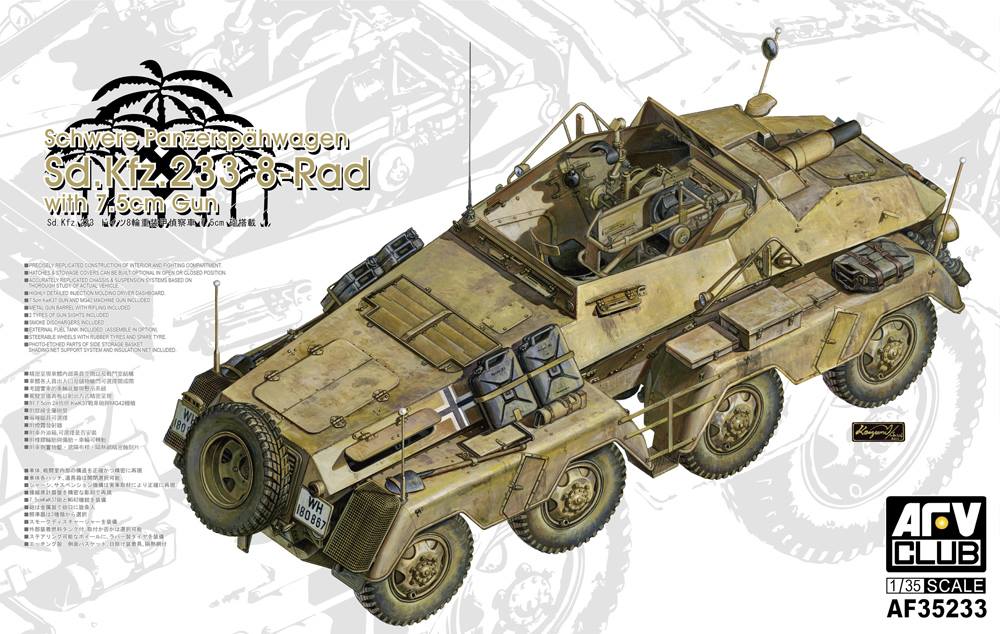 |
|
afvfan
Senior Member
   
Member since: December 2012
Bob
Posts: 1,772
Dec 10, 2012 17:32:38 GMT -5
Dec 10, 2012 17:32:38 GMT -5
|
Post by afvfan on Jul 23, 2015 0:25:53 GMT -5
I may be wrong, but I thought all open topped vehicles interiors were painted the same color as the exterior from the factory. I've seen a few examples where a grey vehicle was repainted yellow while the interior was left alone, but these are rarities.
|
|
|
|
Post by wbill76 on Jul 23, 2015 16:42:02 GMT -5
The 'Tropen' schemes were first authorized in March '41 (2/3 RAL 8000, 1/3 RAL 7008) and a 2nd revised scheme ordered in March '42 (2/3 RAL 8020, 1/3 RAL 7027) and all vehicles that were earmarked for service in N. Africa typically were painted in the Tropen schemes either at the factories if they had specific 'Tropen' modifications done there or at the depots in Italy before being shipped across the Mediterranean. All of the N. Africa 233s were sent over in Nov 1942 so it's possible they could still have gotten the first original Tropen scheme or the 2nd scheme...it would all depend on the paint stock levels at the particular depot at the time they went through it. You could go either way...the likelihood that it would be only in plain 'desert yellow' over panzer gray in my opinion is highly unlikely. That typically applied only to the first few months in '41 before the switch to Tropen schemes was adopted and paint stocks made their way into the hands of units in the field to use for equipment already in theater. Like anything anywhere, it took time for those kinds of things to fully get implemented...but stretching it out to November 1942 to brand new equipment being shipped in from outside is highly unlikely. When you see photos of other equipment being unloaded in Tunisia in the same period of time (Pz III Ns for example where color photos are available), they are clearly sporting the Tropen schemes. That was a longwinded setup for the interior paint question.  Open topped fighting compartments like this typically wouldn't have any Elfenbein used. The sole purpose of Elfenbein was to increase visibility for the crews in enclosed spaces. No need for that in an open-top setting and it had the added problem of making the vehicle easier to spot from the air. Instead they would get the same color as the exterior whatever that might have been. When I did my 222, the 'open top' areas of the gun mount and floor visible through the turret with the screens open were done in Pz Gray to reflect that. Other non visible areas of the interior got the Elfenbein or primer treatment depending. Since these vehicles didn't receive any special 'Tropen' factory modifications I would say the most likely scenario is they came in Pz Gray on the inside of the open fighting compartment from the factory. At the depot they would've gotten an exterior Tropen scheme and the gun and top areas at a minimum would've gotten either the RAL 8000 or RAL 8020 main exterior color. Same thing for the side hatches and angled side areas. Under the gun mount and forward might or might not have been left in Panzer gray, you could exercise some leeway here and be totally plausible IMHO. It's always fun to try to puzzle out what 'should've' been vs. what actually was when it comes to German schemes. The 'Tropen' scheme for example is often very hard to pick out in b/w photos as the two colors used in either version are relatively low contrast to each other. Add in a coat of desert dust and the scheme can virtually vanish entirely.  The photo you posted along with another side-on view are also included in Panzer Tracts No.13. In the side-on photo, you can make out the Tropen pattern pretty clearly along the fenders and hull side. The photo of the gun is very good, high resolution, and clear. It looks a lot closer to RAL 8020 IMHO and is in pretty good condition. The chipping/scratches on the raised viewport visor sure look like Pz Gray to me as well.  |
|
|
|
Post by Tobi on Jul 31, 2015 15:55:34 GMT -5
The only thing I want to add is, I have no reason to believe that at any given time any AFV interior of the German Army was painted in a color called "Elfenbein". To me this color is a myth invented by modelers, who mistook the aged yellowish white of surviving tanks for something else.
In his book "Tigers in the mud" Otto Carius described the interior of his Tiger initially as white, later as black (from the soot of the blowtorch they used to heat up the fighting compartment). Personally I think if it would have been Elfenbein he would have wrote Elfenbein, the man was a pedant.
Second, and more important, you won't find a color called Elfenbein in Wehrmacht supply stock lists for the front. What you do find is an offwhite color called "Grauweiss", which was the color for stencils and permanent whitewashs. Maintenance in the Wehrmacht included paintjob touch-ups and the majority of the tanks was not in that sorry state they are often depicted in by some modelers. This would have meant trouble for the crews, we know something of that kind about the hinomarus on Japanese planes, but different story.
My point is, if I think about the way Germans tend to do things (and I can say that because I am a German engineer), technically we don't supply tanks to our troops and then don't give them the right color at hand to repaint the interiors. Yes, it was a big surprise to some folks that the winter in Russia is freaking cold, but these mistakes originated from other sources. You could also argue that it is possible to mix Elfenbein from Grauweiss and Dunkelgelb, but before October 1942 there was no Dunkelgelb and also mixing is against the pedantic approach a German Army bureaucrat tends to have even in war time, didn't change much...
So, in the end I really don't get into that Elfenbein thing. Of course, uncertainties remain, but that's just my 2 cents. It's a similar discussion like what is the "correct" shade of Dunkelgelb.
|
|
|
|
Post by Tobi on Aug 1, 2015 1:06:01 GMT -5
I need to make another addition here. Without doubt, inside the modelers community, there is a fair share of people out there (and I count myself among them), who are not able to tell apart dust from flaking paint or RAL7008 Graugruen from RAL7021 Dunkelgrau in black-and-white photographs: 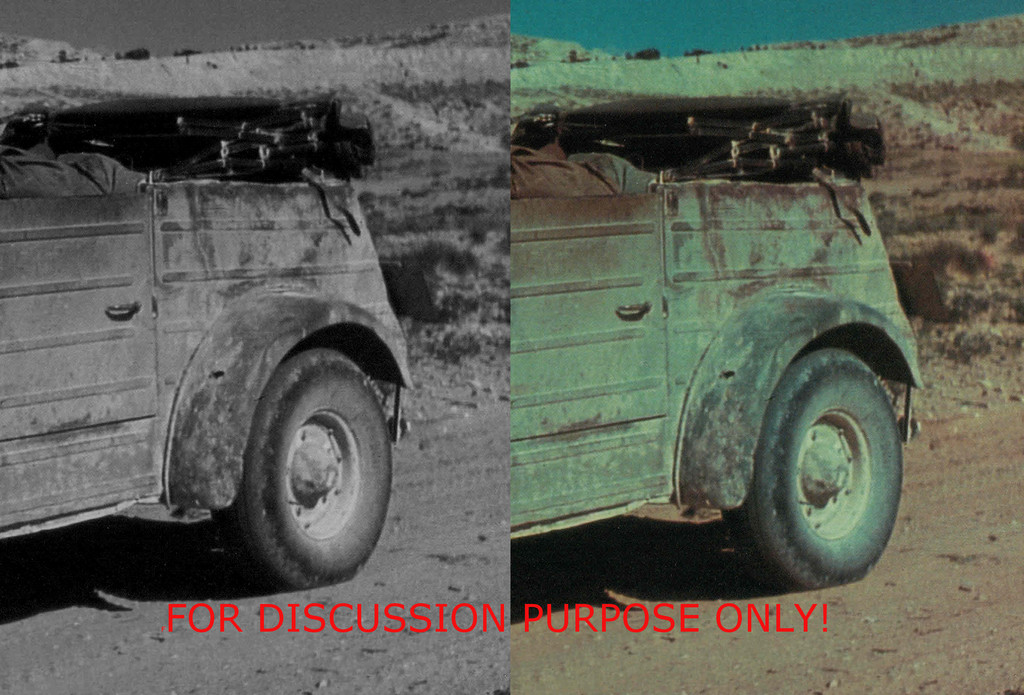 I believe this is another reason why we see so many f**ked up paintjobs. Many hardcore Wehrmacht armor modelers never take the liberty to observe color photographs of modern equipment for comparison and inspiration. If you really want to learn something about the DAK, try to find the book "Afrikakorps in color" by Bernd Peitz from Schiffer Publications. I'm sure Andy (deafpanzer) will confirm this. This is an invaluable(!) source, I even learned something about the Caunter scheme. I remember reading discussions for years about the light blue color, that it is plain wrong and that all the people using it are idiots (the typical internet bollocks), that silver grey is the only truth and then there it was: two British trucks in a full page color photo, parked side by side under a cloudless blue sky, one painted grey and the other painted exactly the same color as the sky above, baby-blue! To me on the view port it is bare metal and the streaks are rust. |
|
BJ---Rest In Peace
Full Member
   Oct '24 Showcased Model Awarded
Oct '24 Showcased Model Awarded
Member since: July 2014
Posts: 378
Jul 24, 2014 12:31:35 GMT -5
Jul 24, 2014 12:31:35 GMT -5
|
Post by BJ---Rest In Peace on Aug 1, 2015 2:45:08 GMT -5
|
|
|
|
Post by Tobi on Aug 1, 2015 2:52:00 GMT -5
Turn them to grey-shades for fun and watch the "magic" happen!  |
|
|
|
Post by wbill76 on Aug 1, 2015 14:19:38 GMT -5
These might be helpful and are posted for discussion purposes only, all three are out of Panzer Tracts No.13 by Jentz & Doyle. High quality photos and printing can make a big difference when it comes to the schemes. Here's a shot of a brand-new 223 in 1942 sitting right outside one of the depots prior to shipment to North Africa. Notice that they didn't bother masking the wheel hubs and just sprayed them with the tires on.  It also has the leather muzzle cap in place on the 7.5cm gun and the shelter top bows in place over the fighting compartment, something you don't see a lot of in pics of these guys.  Take that baby out for a spin and get it nice and dusty and it becomes what you see below. Notice the schwarzgrau jerry can on the side for shade comparison as well as how close the colors match the pith helmets hung on the sides. Lots of dust and streaking over the Tropen scheme but still clearly there under the nice direct lighting that this photo was taken in.  As for that interior shot of the gun, here's the high-res shot that shows a little better the degree of chip/wear on that particular visor. Look closely at the recoil guard bar on the gun itself, you can see some chipping/wear there as well which is an indicator IMHO that the underlying paint is likely the same on both the gun and visor.  |
|
|
|
Post by wbill76 on Aug 1, 2015 15:50:36 GMT -5
I need to make another addition here. Without doubt, inside the modelers community, there is a fair share of people out there (and I count myself among them), who are not able to tell apart dust from flaking paint or RAL7008 Graugruen from RAL7021 Dunkelgrau in black-and-white photographs:  I believe this is another reason why we see so many f**ked up paintjobs. Many hardcore Wehrmacht armor modelers never take the liberty to observe color photographs of modern equipment for comparison and inspiration. It's one of the things that makes N. Africa schemes so appealing IMHO but also creates some very enduring perceptions of the schemes that the box art and kit suppliers also perpetuate...not unlike what they did for years with the two-tone scheme in effect through June 1940 vs. the plain panzer gray that replaced it.  That's not to say that there isn't room for artistic license and expression when it comes to wear and tear of course as every vehicle has a 'life span' to it that the individual builder can choose to depict. Some of the most aesthetically pleasing results probably stretch or exceed the realm of plausibility but that doesn't mean they aren't cool to look at.  When I was working on the StuG III F/8 project (vehicles sent over at roughly the same time as the 223s ironically) to replicate one of the super rare StuG IIIs in Tunisia, I only had this photo to work off of for the Tropen scheme for RAL 8020/RAL7027. 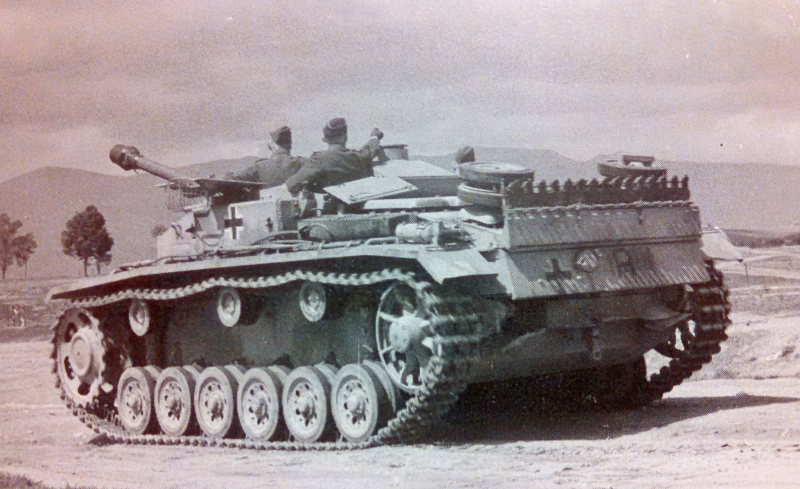 Used the available Model Master enamels for those colors plus the usual weathering/filtering to produce a close match in color. 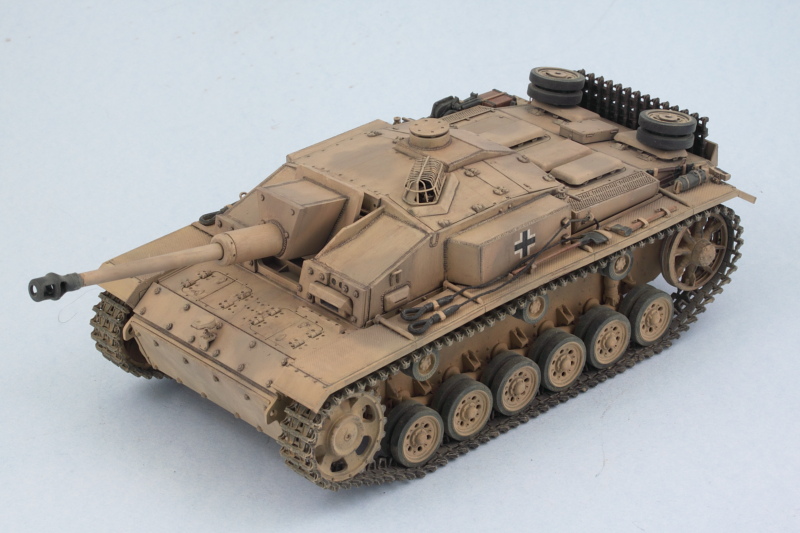 Convert it to grayscale and it virtually disappears, especially since this is under 'ideal' lighting conditions vs. being out in a natural environment with various other variables like shadows, angles, etc. Under 'real world' conditions it could easily look at first glance to be a 'desert yellow' single-color scheme.   |
|
|
|
Post by Tobi on Aug 1, 2015 17:14:56 GMT -5
I need to make another addition here. Without doubt, inside the modelers community, there is a fair share of people out there (and I count myself among them), who are not able to tell apart dust from flaking paint or RAL7008 Graugruen from RAL7021 Dunkelgrau in black-and-white photographs:  I believe this is another reason why we see so many f**ked up paintjobs. Many hardcore Wehrmacht armor modelers never take the liberty to observe color photographs of modern equipment for comparison and inspiration. It's one of the things that makes N. Africa schemes so appealing IMHO but also creates some very enduring perceptions of the schemes that the box art and kit suppliers also perpetuate...not unlike what they did for years with the two-tone scheme in effect through June 1940 vs. the plain panzer gray that replaced it.  That's not to say that there isn't room for artistic license and expression when it comes to wear and tear of course as every vehicle has a 'life span' to it that the individual builder can choose to depict. Some of the most aesthetically pleasing results probably stretch or exceed the realm of plausibility but that doesn't mean they aren't cool to look at.  When I was working on the StuG III F/8 project (vehicles sent over at roughly the same time as the 223s ironically) to replicate one of the super rare StuG IIIs in Tunisia, I only had this photo to work off of for the Tropen scheme for RAL 8020/RAL7027.  Used the available Model Master enamels for those colors plus the usual weathering/filtering to produce a close match in color.  Convert it to grayscale and it virtually disappears, especially since this is under 'ideal' lighting conditions vs. being out in a natural environment with various other variables like shadows, angles, etc. Under 'real world' conditions it could easily look at first glance to be a 'desert yellow' single-color scheme.   Bill, totally second that about the contrasts, early war Panzergrau and brown is indeed another good example, and yes, life span is the key! I'm not against wear in general, but in logical places and in credible ways. It's just, sometimes I think for example, really, thisPanther was in service at Kursk, if it had 100 hours of battle time it was a vet, and that guy makes it look like Berlin 1946?! The exhaust rusted like it will fall apart any time from looking at, the hatches scratched as if they had been in use for 3 or 4 years... artistic license and personal taste, okay, but there is a thin red line between cool and implausible. I found it a good thing to take macro pictures of my models during the chipping process, to check if it still looks right. |
|
BJ---Rest In Peace
Full Member
   Oct '24 Showcased Model Awarded
Oct '24 Showcased Model Awarded
Member since: July 2014
Posts: 378
Jul 24, 2014 12:31:35 GMT -5
Jul 24, 2014 12:31:35 GMT -5
|
Post by BJ---Rest In Peace on Aug 1, 2015 17:37:18 GMT -5
|
|
|
|
Post by wbill76 on Aug 1, 2015 19:31:20 GMT -5
That's a cool shot of the spot light and the trailer. This is where the 'gray' (pun intended!) really enters any discussion about colors and schemes when trying to work only from b/w photos, there's only so much you can divine if the photo is the ONLY source of information being drawn on. It doesn't help that a lot of older reference books out there also are inaccurately captioned and perpetuate things that have since been updated with newer information. Even when we do get our hands on those rare actual color photos, then the problem becomes one of film type, quality of the negatives and photo reproductions, photographic conditions, etc. as to how 'true' even those colors really are. It could be worse, we could be having an 'Ancient Aliens' type of conversation.  This is where ordered schemes/colors and date-stamped documents help but only to a certain point. Just because something was ordered on such-and-such date doesn't mean that it was implemented 100% at 12:01 am on that exact date. German war production was notorious about using up existing parts/stocks first at the individual factories, assembly lines, or depots and then converting over to whatever new features/variants were next on the list...making it hard to truly say much at all with 100% certainty beyond just broad generalized 'fences' when it comes to actual dates and implementations for switch-overs.  Also have to keep in mind that all new factory-produced equipment had to be accepted (and paid for!) by the Waffenamt and military inspectors before it would then be distributed out to the units. Paperwork is the lifeblood of bureaucracy after all!  It gets even worse when we start talking about field implementations. I've seen some great photos that showed German equipment in late 1940 still sporting pre-war three tone hard-edge schemes right next to brand new equipment in straight panzer gray...meaning they weren't just 1 but 2 schemes behind in their practices!  Another great example that comes to mind are the infamous brand-new DY and white-washed LAH Pz IV Gs that were sent to Kharkov in January 1943 a full month before DY and the field-applied camo officially replaced Panzer Gray as the standard scheme in Feb 1943.  |
|
BJ---Rest In Peace
Full Member
   Oct '24 Showcased Model Awarded
Oct '24 Showcased Model Awarded
Member since: July 2014
Posts: 378
Jul 24, 2014 12:31:35 GMT -5
Jul 24, 2014 12:31:35 GMT -5
|
Post by BJ---Rest In Peace on Aug 1, 2015 20:36:57 GMT -5
Ohh I know. that's why I put that spotlight in this. From all the photos I have seen I would have sworn they would have been yellow or grey,But I am assuming since most if not all were under Luftwaffe control.(What I have read anyway) they are/were painted with a Luftwaffe RAL Color Scheme, from what I understand is different then the Wehrmacht RAL.
From what I read there was a new RAL standard implemented after the war so many of the RAL #s are useless
|
|
|
|
Post by Tobi on Aug 2, 2015 2:30:47 GMT -5
Not to forget diverted equipment Bill! Vehicles meant for the DAK with the 8000/7008 or 8020 paintjob could be suddenly found again in the Russian steppe!  The green for 3-tone Panzer camo has an eventful history of itself, just like Dunkelgelb. I will try to shortly summarize from "Camouflage & Markings" Vol.1 by Mark Healy: At the beginning it had no RAL code just like Dunkelgelb, but it was known in the Luftwaffe as RLM62, employed in an early four-color scheme on bombers and transport planes. The color was dropped when the Luftwaffe switched to an upper surface scheme consisting only of two colors. Existing stocks of RLM62 were then to be used up for painting airfield buildings. In H.M.1943, Nr.181 the color finally received the RAL code 6003. To make things more complicated, there existed a second "Gruen 28", which had incidentally been in use for the 1933-37 Reichswehr paint-jobs and this was registered in the Luftwaffe RLM table as an authorized substitute for RLM62! So, on the searchlight example, it can be either RLM or RAL or Reichswehr green, who knows? Billiejean, I love your grey-tone experiments. You really made my day!  Regarding Wehrmacht RAL codes, most if not all were deleted from RAL standard after the war. |
|
|
|
Post by wbill76 on Aug 2, 2015 11:33:48 GMT -5
Ohh I know. that's why I put that spotlight in this. From all the photos I have seen I would have sworn they would have been yellow or grey,But I am assuming since most if not all were under Luftwaffe control.(What I have read anyway) they are/were painted with a Luftwaffe RAL Color Scheme, from what I understand is different then the Wehrmacht RAL. From what I read there was a new RAL standard implemented after the war so many of the RAL #s are useless Herein lies another of those wonderful contradictions of competing bureaucracies...the Luftwaffe did have its own codes and authorized paint schemes (as did the Kriegsmarine) separate from the Wehrmacht...RLM does stand for the Reichsluftfahrt Ministerium after all! Goering couldn't stand for anyone to interfere in his empire if he could help it.  As Tobi mentions, sometimes there was overlap/commonalities between them, sometimes not. I'm sure it drove the supply personnel nuts trying to keep up with it all...especially when you had Luftwaffe units serving in the field alongside Wehrmacht or Waffen-SS vs. protecting cities or other 'fixed' installations.  Modern RAL codes aren't very helpful in trying to interpret the war codes...so much has changed with them that it's problematic at best. Too bad as it would be all too easy to just take a paint chip down to your local hardware store and get a lifetime supply of the 'correct' colors...  The RAL codes referenced in the war orders do help when talking about distinguishing between different colors though, especially since some of the names used are counterintuitive to the actual colors and the modern paint makers are more concerned with trying to cater to modeler-invented terms/distinctions as their targeted customers. Testors for example calls their versions of RAL 8020 and RAL 7027 Afrika Braun '42 and Afrika Dunkelgrau '42 respectively...neither of which were ever official designations (and the Dunkelgrau doesn't look very 'grau' or 'dunkel' in the bottle!)  It isn't a problem limited to just the WW2 era either...people still argue over the Federal Standard (FS) designations for paint used on US and NATO equipment just as much.  |
|
|
|
Post by wbill76 on Aug 2, 2015 11:41:13 GMT -5
Not to forget diverted equipment Bill! Vehicles meant for the DAK with the 8000/7008 or 8020 paintjob could be suddenly found again in the Russian steppe!  Or the fact that certain zones in Southern France and Southern Russia were also designated as 'Tropen' areas where the scheme could be used officially vs. the 'standard' Pz Gray. Add in that units were often shifted around (particularly those used in the Crimea and Caucasus) to plug holes in other areas of the front and you can get some pretty interesting circumstances in 1942 when it comes to vehicle schemes and possibilities. Honestly though, what were they thinking? Didn't they know that modelers expect more consistency and definition when it comes to this kind of thing? How else can we have solid judging at competitions!  |
|
BJ---Rest In Peace
Full Member
   Oct '24 Showcased Model Awarded
Oct '24 Showcased Model Awarded
Member since: July 2014
Posts: 378
Jul 24, 2014 12:31:35 GMT -5
Jul 24, 2014 12:31:35 GMT -5
|
Post by BJ---Rest In Peace on Aug 2, 2015 13:07:10 GMT -5
PROBLEM SOLVED 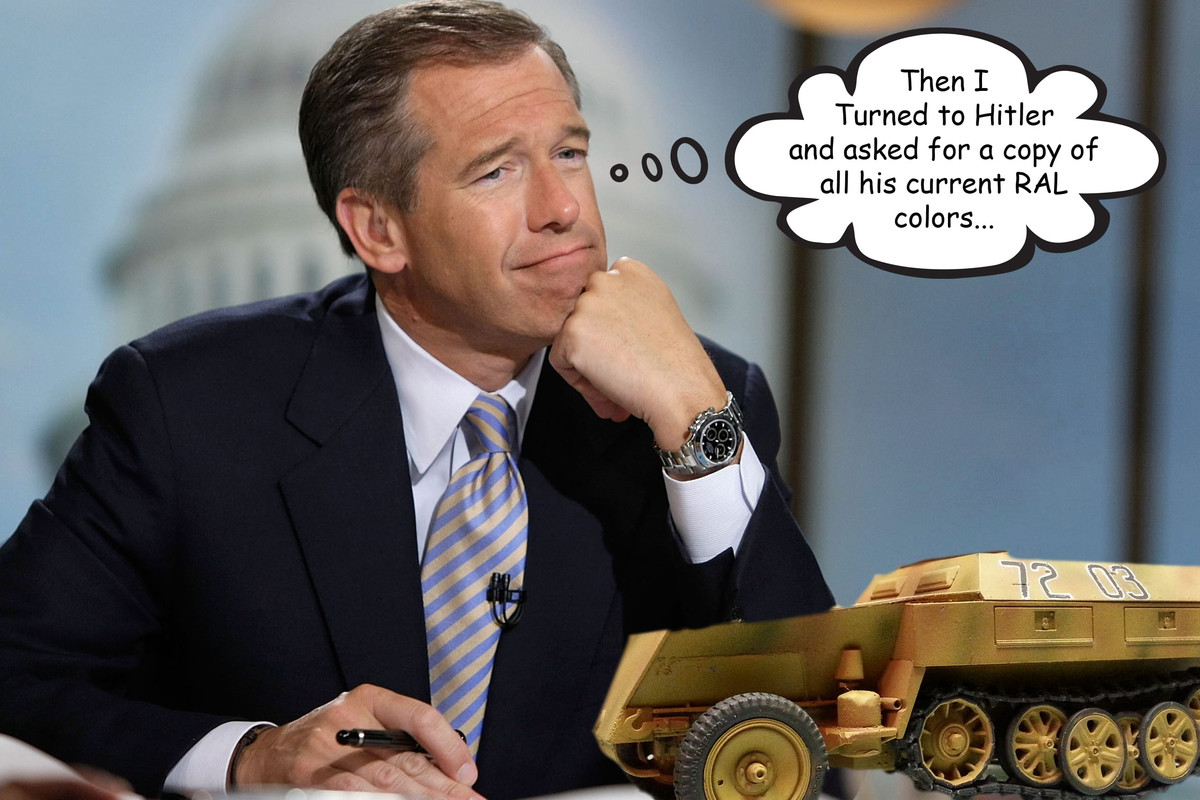 |
|
|
|
Post by wbill76 on Aug 2, 2015 14:28:18 GMT -5
I'm calling Brian Williams!  |
|
|
|
Post by Tobi on Aug 2, 2015 14:33:54 GMT -5
I'm calling Brian Williams!  Don't forget to mention the "scale effect"! |
|